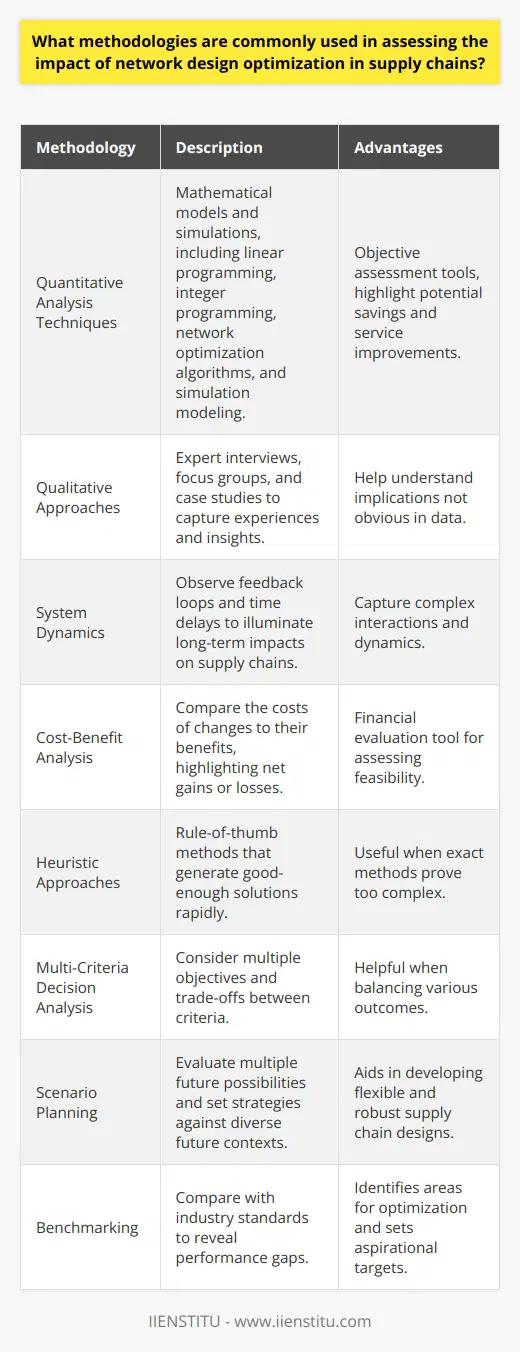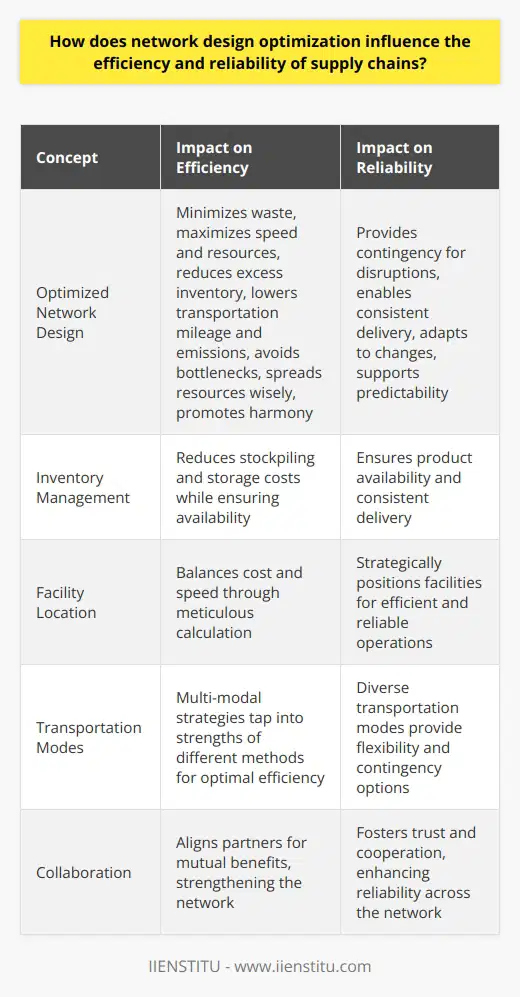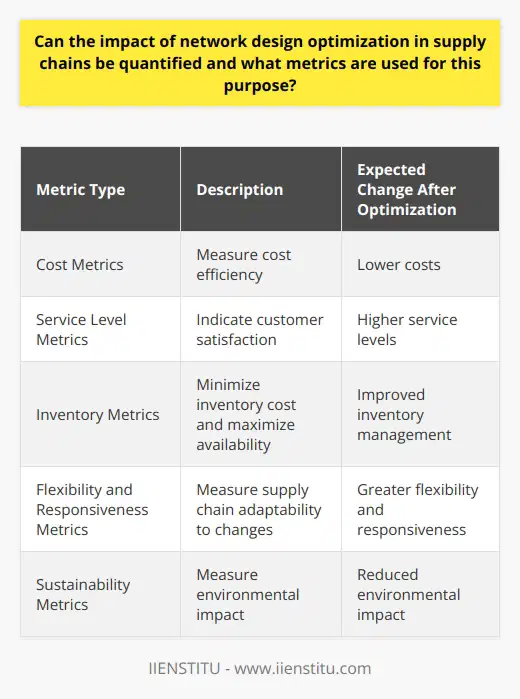
The Evolving Landscape of Supply Chain Network Design Optimization
In the intricately connected world of supply chain management, efficiency and adaptability are paramount. One critical aspect of ensuring smooth operations in supply chains is network design optimization--a multifaceted approach to crafting and managing the logistical frameworks that businesses rely on. By intelligently designing their networks, companies can achieve faster delivery times, reduce costs, and enhance service quality, thereby gaining a competitive edge. In the following exploration, we assess the impact of such optimizations, contemplating whether these meticulous alterations can truly revolutionize supply chain dynamics.
Furthermore, the emergence of specialized education and training programs plays a significant role in empowering professionals with the knowledge and tools necessary for effective network design optimization. These educational platforms delve into the complexities of supply chain management, offering insights into strategies for overcoming logistical challenges and implementing best practices for supply chain network design. As the industry continues to evolve, the integration of these learning opportunities ensures that the workforce remains adept at navigating the ever-changing landscape, ultimately contributing to the overall integrity and efficiency of supply chains. Through this blend of academic rigor and practical application, the potential for transformative improvements in supply chain management is immense, signaling a promising horizon for businesses worldwide.
Definition of Network Design Optimization
Network design optimization refers to the methodical process aimed at improving a supply chain network's efficiency and effectiveness. It involves reassessments and enhancements of a network's layout, including distribution centers, transportation routes, and inventory levels. This strategic refinement is not just about marginal improvements; it seeks to fundamentally reshape how products and information flow from origin to consumer. By leveraging advanced analytics, algorithms, and models, network optimization ensures that the right goods reach the right place at the right time, with minimal waste and maximum value creation.
Importance and Role of Network Design Optimization
The inherent complexity and volatility of global supply chains necessitate a robust and responsive network design. With consumer expectations ceaselessly escalating and market conditions ever-fluctuating, businesses must adapt their logistical strategies promptly and effectively. Network design optimization provides a structured approach to do just that--it fortifies supply chains against disarray, engenders resilience, and fosters growth. In a world where efficiency translates directly to competitiveness, optimizing network design isn't just beneficial; it's imperative.
Scalability: Scalability is a critical principle of network design optimization, where the network must be capable of adjusting to changes in volume without compromising performance. In the current market scenario, capacity for growth is a necessary provision as companies face unpredicted surges in demand or expansion into new territories. An optimized network is engineered with flexible parameters to scale up or down prudently, reflecting the evolving needs of the business.
Redundancy: Redundancy in network design is often viewed through a dual lens—blessing or burden. While duplication of elements such as routes, suppliers, or facilities might seem like extra baggage in the short term, these redundancies can serve as essential backups during disruptions. They provide alternate paths for fulfillment processes, thereby enhancing reliability and continuity of service.
Performance: An optimized network design directly influences the overall performance of a supply chain. By strategically placing distribution centers, streamlining transportation routes, and ensuring consistent inventory flow, a network can vastly improve delivery speed and accuracy. Performance metrics such as lead time, service levels, and cost per delivery are scrutinized and optimized to meet the ever-increasing service demands of customers.
Security: Today's supply chains face a myriad of threats, from cyberattacks to physical breaches. A securely optimized network is not just guarded against unauthorized data access, but also ensures the protection of goods throughout the supply chain. Amidst the constant evolution of risk, supply networks must be designed to deter attacks while preserving smooth and secure operations.
Manageability: An intricate network, teeming with interconnected elements, must remain manageable. This involves creating a design that can be effectively monitored and controlled, ensuring that each element adheres to the operational mandate. Complex networks might necessitate advanced management tools or processes but the endpoint remains clear: keep the network running efficiently and effectively.
Cost-effectiveness: At the crux of network design optimization is the overarching goal of cost-effectiveness. An optimized network steers away from unnecessary expenses by eliminating inefficiencies, leveraging economies of scale, and implementing smarter procurement practices. Done adeptly, it converts investments into palpable benefits, delivering value to both the business and its clientele.
As Michael Porter emphasizes in his seminal work, Competitive Advantage: Creating and Sustaining Superior Performance, "The essence of strategy is choosing to perform activities differently than rivals do" (Porter, 1998, p. 41). Network design optimization epitomizes this strategic differentiation, enabling companies to outperform their competitors through superior logistical prowess.
Understanding the Business Goals and Requirements:
Key Principles of Network Design Optimization
1- Scalability: Scalability is a critical principle of network design optimization, where the network must be capable of adjusting to changes in volume without compromising performance. In the current market scenario, capacity for growth is a necessary provision as companies face unpredicted surges in demand or expansion into new territories. An optimized network is engineered with flexible parameters to scale up or down prudently, reflecting the evolving needs of the business.
Audit of the Current Network Infrastructure:
2- Redundancy: Redundancy in network design is often viewed through a dual lens--blessing or burden. While duplication of elements such as routes, suppliers, or facilities might seem like extra baggage in the short term, these redundancies can serve as essential backups during disruptions. They provide alternate paths for fulfillment processes, thereby enhancing reliability and continuity of service.
Identifying the Network Needs and Trends:
3- Performance: An optimized network design directly influences the overall performance of a supply chain. By strategically placing distribution centers, streamlining transportation routes, and ensuring consistent inventory flow, a network can vastly improve delivery speed and accuracy. Performance metrics such as lead time, service levels, and cost per delivery are scrutinized and optimized to meet the ever-increasing service demands of customers.
Designing the New Network Following Optimization Principles:
4- Security: Today's supply chains face a myriad of threats, from cyberattacks to physical breaches. A securely optimized network is not just guarded against unauthorized data access, but also ensures the protection of goods throughout the supply chain. Amidst the constant evolution of risk, supply networks must be designed to deter attacks while preserving smooth and secure operations.
Implementation of the New Design:
5- Manageability: An intricate network, teeming with interconnected elements, must remain manageable. This involves creating a design that can be effectively monitored and controlled, ensuring that each element adheres to the operational mandate. Complex networks might necessitate advanced management tools or processes but the endpoint remains clear: keep the network running efficiently and effectively.
Monitoring and Improvement:
Load Balancing: Load balancing refers to the distribution of workloads across multiple resources in the network. By ensuring that no single node or pathway becomes overwhelmed, this technique enhances the efficiency and reliability of the network. Load balancing techniques can vary from simple round-robin methods to complex, data-driven dynamic allocation, all in pursuit of an evenly spread network load.
Path Optimization: Path optimization involves the strategic selection of routes within a network to expedite flow and reduce costs. Utilizing algorithms and real-time data, this technique assesses multiple pathways to determine the most efficient and least congested routes for transportation, thereby reducing lead times and improving service quality.
Bandwidth Management: In the context of supply chain networks, bandwidth management addresses the allocation of physical and informational capacity across the network. Strategies such as prioritizing certain shipments or controlling data flow ensure effective use of available capacity and can significantly boost throughput.
Virtualization: Virtualization has begun to play a key role in network design optimization. It allows for the creation of virtual—rather than physical—versions of network resources, providing flexibility and improving disaster recovery. This technique supports scalability and efficient resource utilization, transforming fixed infrastructure into a more dynamic asset.
6- Cost-effectiveness: At the crux of network design optimization is the overarching goal of cost-effectiveness. An optimized network steers away from unnecessary expenses by eliminating inefficiencies, leveraging economies of scale, and implementing smarter procurement practices. Done adeptly, it converts investments into palpable benefits, delivering value to both the business and its clientele.
As Sunil Chopra and Peter Meindl note in their book, Supply Chain Management: Strategy, Planning, and Operation, "The goal of network design is to maximize the firm's profits while satisfying customer needs in target markets" (Chopra & Meindl, 2016, p. 128). These principles collectively strive towards this goal, crafting a network that is not just operationally sound but also strategically superior.
Detailed Analysis of Leading Optimization Tools:
Comparisons and Juxtaposition between the Tools:
Discussing the Balance Between These Principles
The quest for network optimization is akin to a tightrope walk, balancing the multitude of principles mentioned earlier. It's a dance between the scalable and the cost-effective, the robust and the flexible. Each network has its unique priorities and striking the right equilibrium between these elements is the cornerstone of a truly optimized system.
Assessing the Ideal Tool Based on the Specific Needs of a Network:
In their influential work, Designing and Managing the Supply Chain, David Simchi-Levi, Philip Kaminsky, and Edith Simchi-Levi underscore this balancing act: "The challenge in network design is to balance the competing goals of low cost and high responsiveness" (Simchi-Levi et al., 2008, p. 89). This encapsulates the crux of the optimization challenge--navigating the trade-offs to arrive at a design that maximizes value.
Successful Optimization in a Large Corporation:
Steps in Network Design Optimization
1- Understanding the Business Goals and Requirements: Like any substantive endeavor, network design optimization begins with a foundational understanding of business goals and requirements. These objectives dictate the strategic direction and desired outcomes for the network. From achieving swift delivery to maintaining regulatory compliance, every facet of the optimization process must align with the overarching business goals.
Enhancement of a Start-Up's Network through Optimization:
2- Audit of the Current Network Infrastructure: Before embarking on optimization, a thorough audit of the current network infrastructure is indispensable. This assessment unlocks insights into existing bottlenecks, redundant processes, or untapped opportunities for efficiency improvements. An audit becomes the roadmap from where the supply chain stands to where it needs to go.
Discussion and Analysis of the Key Lessons from Each Case Study:
3- Identifying the Network Needs and Trends: With the audit in the rearview mirror, the next step involves identifying both immediate and long-term network needs along with prevailing market trends. Has e-commerce growth shifted focus to last-mile delivery optimization? Has a change in consumer behavior necessitated a different inventory approach? Understanding these dynamics is crucial for a network that not only serves current demands but is also braced for future shifts.
Technological Complexity: The technological complexity of optimizing a network can daunt even the most seasoned professionals. With an array of systems, software solutions, and analytical tools at their disposal, managers must navigate through a maze of options, all while keeping the network aligned with the strategic vision.
Budget Constraints: Budget constraints pose an ongoing challenge in network design optimization efforts. While the promise of long-term savings and efficiency is alluring, the upfront investment often requires convincing justification to secure the necessary funding.
Limited Skilled Personnel: The specialized skills required to implement network optimization strategies are in high demand, and finding the right talent can be challenging. This underscores the importance of training and development within organizations to cultivate in-house expertise.
4- Designing the New Network Following Optimization Principles: Designing a new network or tweaking an existing one in accordance with the principles of optimization requires meticulous planning. Here, the intertwined factors of scalability, redundancy, performance, security, manageability, and cost-effectiveness are sculpted into a coherent blueprint, preparing the foundation for what will become an improved logistical network.
Emerging Trends
5- Implementation of the New Design: The implementation phase is where strategic plans converge with reality. It's a pivotal moment laden with the excitement of innovation and the rigor of execution. Through careful coordination and project management, the new design is brought to life, evolving the supply chain network into a better-tuned mechanism of the business operation.
Potential Impact of Advancements such as AI and Machine Learning
Predictions for Future Challenges and Opportunities
6- Monitoring and Improvement: Upon bringing the new network design into operation, the process does not stall. Continuous monitoring ensures that initial metrics are meeting targets and forecasts, while ongoing improvement processes refine and enhance the network, adapting to unforeseen challenges and capitalizing on emergent opportunities.
These steps, when executed with diligence and foresight, pave the way for a network that is not just optimized but also future-ready. As noted in Global Supply Chain and Operations Management by Dmitry Ivanov, Alexander Tsipoulanidis, and Jörn Schönberger, "The goal of network design is to provide an efficient and effective supply chain infrastructure to support the firm's long-term competitive strategy" (Ivanov et al., 2019, p. 205). Each step in this process contributes to this overarching goal.
Network Design Optimization Techniques
1- Load Balancing: Load balancing refers to the distribution of workloads across multiple resources in the network. By ensuring that no single node or pathway becomes overwhelmed, this technique enhances the efficiency and reliability of the network. Load balancing techniques can vary from simple round-robin methods to complex, data-driven dynamic allocation, all in pursuit of an evenly spread network load.
2- Path Optimization: Path optimization involves the strategic selection of routes within a network to expedite flow and reduce costs. Utilizing algorithms and real-time data, this technique assesses multiple pathways to determine the most efficient and least congested routes for transportation, thereby reducing lead times and improving service quality.
3- Bandwidth Management: In the context of supply chain networks, bandwidth management addresses the allocation of physical and informational capacity across the network. Strategies such as prioritizing certain shipments or controlling data flow ensure effective use of available capacity and can significantly boost throughput.
4- Virtualization: Virtualization has begun to play a key role in network design optimization. It allows for the creation of virtual--rather than physical--versions of network resources, providing flexibility and improving disaster recovery. This technique supports scalability and efficient resource utilization, transforming fixed infrastructure into a more dynamic asset.
5- Use of Software-Defined Networking (SDN): Software-defined networking (SDN) represents a shift from hardware-centric networking to a more software-driven approach. By abstracting the control layer from the physical network, SDN allows for more agile management, responsive provision of network resources, and the ability to rapidly adapt to changing business needs.
These network design optimization techniques are the toolkit of the modern supply chain professional, enabling them to craft networks that are resilient, responsive, and resource-efficient. As highlighted in Sustainable Supply Chains: A Research-Based Textbook on Operations and Strategy by Yann Bouchery, Charles J. Corbett, Jan C. Fransoo, and Tarkan Tan, "The application of advanced optimization techniques can lead to significant improvements in supply chain performance" (Bouchery et al., 2017, p. 143). Mastering these techniques is thus a key to unlocking the full potential of network optimization.
Network Design Optimization Tools and Software
Detailed Analysis of Leading Optimization Tools
Network design optimization software tools come in various forms, offering a range of functionalities from modeling and simulation to real-time decision support. Some tools specialize in specific aspects like route optimization, while others provide comprehensive suites that address the full gamut of optimization needs.
For instance, SupplyChainGuru X by LLamasoft is a potent tool that enables end-to-end supply chain design and analysis, supporting strategic decision-making through advanced algorithms and scenario testing. On the other hand, tools like Logility Voyager Solutions focus more on integrated business planning, offering capabilities for demand, inventory, and replenishment optimization.
Comparisons and Juxtaposition between the Tools
When considering optimization tools, it is vital to compare and contrast their features, ease of use, integration capabilities, and ultimately their compatibility with the organization's unique needs. A tool that excels in complex algorithmic solutions might be overkill for a smaller enterprise with straightforward network challenges.
Oracle's Transportation Management System, for example, is renowned for its robustness in managing global transportation networks, offering real-time visibility and control. However, this might not be the ideal choice for a company with a more localized distribution network, where a tool like AnyLogic, with its focus on simulation and modeling, could yield better results.
Assessing the Ideal Tool Based on the Specific Needs of a Network
Selecting the ideal tool hinges on a granular understanding of the network's specific requirements. Factors such as the size of the network, the complexity of its operations, and the strategic focus areas are all instrumental in identifying the perfect fit. The ideal tool should not only solve the current challenges but also scale with future developments of the network.
For a company looking to optimize its last-mile delivery operations, a tool like Routific, with its advanced route optimization capabilities, could be the way to go. However, for an enterprise focusing on warehouse efficiency, Optricity's solutions for slotting optimization and warehouse layout design might prove more beneficial.
As underscored in Designing and Implementing Global Supply Chain Management by Joshi Sudhir and Srivastava Samir, "The selection of appropriate technology tools is crucial for effective supply chain network design and optimization" (Sudhir & Srivastava, 2016, p. 218). The right tool can be a game-changer, automating complex processes, providing data-driven insights, and ultimately driving the network towards optimal performance.
Case Studies of Effective Network Design Optimization
Successful Optimization in a Large Corporation
Consider a multinational corporation with a sprawling supply chain network that implemented a comprehensive network optimization. They reassessed their distribution centers and routes, realigned their inventory deployment, and leveraged cutting-edge tools for continuous improvement. The payoff was significant--reduced lead times, cost savings, and improved sustainability.
One such example is Walmart, which undertook a major supply chain overhaul to optimize its network. As detailed in Walmart: Key Insights and Practical Lessons from the World's Largest Retailer by Natalie Berg and Bryan Roberts, "Walmart has continually evolved its supply chain, investing in new technology, automation, and processes to drive efficiency and maintain its competitive edge" (Berg & Roberts, 2012, p. 97). By redesigning its network, Walmart was able to significantly reduce costs, improve inventory management, and enhance its customer service.
Enhancement of a Start-Up's Network through Optimization
Start-ups, with their nimbler structures, also benefit from network optimization. One emerging e-commerce player reconfigured their supply chain by integrating advanced analytics for demand forecasting, optimizing their packaging and shipping methods, and streamlining supplier relationships. The result? Enhanced customer satisfaction and a robust foundation for scaling their operations.
Warby Parker, the eyewear retailer, is a prime example of a start-up that leveraged network design optimization to fuel its growth. As recounted in Retail Disruptors: The Spectacular Rise and Impact of the Hard Discounters by Jan-Benedict Steenkamp and Laurens Sloot, "Warby Parker's innovative supply chain, which involves direct sourcing from manufacturers and a home try-on program, has been key to its success" (Steenkamp & Sloot, 2019, p. 142). By optimizing its network for agility and customer-centricity, Warby Parker disrupted the traditional eyewear industry.
Discussion and Analysis of the Key Lessons from Each Case Study
Key takeaways from detailed case studies generally revolve around the imperatives of customization and attentiveness to shifting market conditions. Each successful optimization is a testament to the fact that a one-size-fits-all approach is untenable, and that meticulous, data-driven adjustments aligned with specific business objectives yield the most fruit.
Moreover, these case studies highlight the importance of network design in supply chain as a continuous process. As markets evolve and customer expectations shift, the network must also adapt. Walmart's ongoing supply chain evolution and Warby Parker's agile network design underscore this point--optimization is not a one-off event but a perpetual pursuit.
Challenges in Network Design Optimization
1- Technological Complexity: The technological complexity of optimizing a network can daunt even the most seasoned professionals. With an array of systems, software solutions, and analytical tools at their disposal, managers must navigate through a maze of options, all while keeping the network aligned with the strategic vision.
2- Budget Constraints: Budget constraints pose an ongoing challenge in network design optimization efforts. While the promise of long-term savings and efficiency is alluring, the upfront investment often requires convincing justification to secure the necessary funding.
3- Limited Skilled Personnel: The specialized skills required to implement network optimization strategies are in high demand, and finding the right talent can be challenging. This underscores the importance of training and development within organizations to cultivate in-house expertise.
4- Technological Advancements and Need for Continual Learning and Adaptation: In a domain perpetually in flux, staying abreast of technological advancements is non-negotiable. Constant learning and adaptation are required to keep the network design in line with contemporary standards and to leverage emerging tools and methodologies.
As outlined in Dynamic Supply Chain Alignment: A New Business Model for Peak Performance in Enterprise Supply Chains Across All Geographies by John Gattorna, "The challenges in supply chain network design are manifold, ranging from the strategic to the operational, and from the technological to the human" (Gattorna, 2016, p. 87). Navigating these challenges requires a deft blend of technical acumen, strategic foresight, and adaptive leadership.
Offering Solutions to These Challenges
Solutions to these challenges require a combination of strategic planning, investment in human capital, and a proactive stance on innovation. By fostering
Frequently Asked Questions
What methodologies are commonly used in assessing the impact of network design optimization in supply chains?
Assessing Network Design Optimization
A Multifaceted Challenge
Network design plays a critical role in supply chain management. Managers look to optimize network configurations. They aim to minimize costs and improve service levels. Evaluating these efforts involves using various methodologies.
Quantitative Analysis Techniques
Quantitative methods offer objective assessment tools. They often involve mathematical models and simulations. These approaches include:
- Linear programming
- Integer programming
- Network optimization algorithms
- Simulation modeling
Each method assesses cost, time, and resources differently. They highlight potential savings and service improvements.
Qualitative Approaches
Aside from numbers, one considers the human angle. Techniques include:
- Expert interviews
- Focus groups
- Case studies
These methods capture experiences and insights. They help understand implications not obvious in data.
System Dynamics
System dynamics focus on complex interactions. They observe feedback loops and time delays. These models illuminate long-term impacts on supply chains.
Cost-Benefit Analysis
This is a financial evaluation tool. It compares the costs of changes to their benefits. It highlights net gains or losses from design optimizations.
Heuristic Approaches
Heuristics are rule-of-thumb methods. They generate good-enough solutions rapidly. Heuristics are useful when exact methods prove too complex.
Multi-Criteria Decision Analysis
This approach considers multiple objectives. It is useful when trade-offs between criteria exist. Decision-makers can weigh different outcomes against each other.
Scenario Planning
Scenario planning evaluates multiple future possibilities. It sets strategies against diverse future contexts. It aids in developing flexible, robust supply chain designs.
Benchmarking
Comparing with industry standards can reveal performance gaps. Benchmarking identifies where to focus optimization efforts. It serves as an aspirational target for supply chain configurations.
Multiple methodologies guide network design optimization assessment. Each addresses different aspects of the complex supply chain systems. Employing a mix of these methods ensures a comprehensive analysis. This balance supports informed decision-making for optimal network configuration.

How does network design optimization influence the efficiency and reliability of supply chains?
Network Design Optimization: A Pillar for Supply Chain Mastery
Efficiency: The Lifeblood of Supply Chains
Efficiency in supply chains is non-negotiable. It dictates pace, cost saving, and performance. A well-optimized network assures minimal waste. Speed and resource maximization follow. Additionally, it trims excess inventory. It reduces mileage for transportation. This, in turn, lowers emissions.
An optimized network steers clear of bottlenecks. It spreads resources wisely across the chain. Balance remains key here. A lopsided network invites inefficiency. In contrast, a well-planned one promotes harmony.
Reliability: Building Trust in Supply Chains
Reliability hinges on meeting expectations. It means delivering consistently, without fail. Optimized designs are critical for reliability. They provide contingency for disruption. Absence of a resilient plan risks faltering. It could break trust with customers.
Predictability yields reliability. This comes from robust design. It involves accurate data employment. It demands precise forecasting. And it insists on rigorous stress testing.
Networks must adapt to flux. They grow rigid without constant updates. Such stagnation kills reliability.
The Interplay of Efficiency and Reliability
Efficiency and reliability are not mutually exclusive. They need each other to thrive. Supply chain leaders recognize this interdependence. They leverage it for competitive advantage.
To illustrate, consider inventory management. Optimized networks reduce stockpiling. This minimizes storage costs. Yet, they also ensure availability. This, in essence, embodies efficient reliability.
Tools and Strategies for Optimization
Several tools come into play here. Software aids in intricate planning. Simulation models forecast network behavior. Analytics unveil hidden inefficiencies.
These tools support strategic choices. Location of facilities is one such choice. It involves meticulous calculation. It balances cost and speed.
Transportation modes also reflect optimization. Multi-modal strategies often prevail. They tap into strengths of different methods.
Collaboration is critical as well. Partners can align for mutual benefits. It strengthens the whole network.
Network design optimization is pivotal. It can make or break supply chain success. Such optimization requires ongoing effort. It also demands astute strategic planning. Those who master it will lead. They will offer better service. And they will enjoy a stronger market position.
In conclusion, a supply chain thrives on optimized design. Efficiency and reliability grow from this root. Together, they build resilient, high-performing networks. These are the pillars of modern supply chains.

Can the impact of network design optimization in supply chains be quantified and what metrics are used for this purpose?
Impact Quantification in Supply Chain Network Design
Optimizing a supply chain's network design boosts efficiency. Analysts can quantify this impact. They use specific metrics. These metrics track performance improvements.
Key Performance Indicators (KPIs)
When we optimize networks, we aim for better KPIs. KPIs provide clarity on performance. They must align with business goals.
Cost Metrics:
Total Logistics Cost: It encompasses transportation, warehousing, and inventory costs.
Cost per Unit Shipped: It breaks down costs for each unit.
Freight Cost: Total cost of transporting goods.
These metrics measure cost efficiency. Lower costs suggest better design. Costs must decline post-optimization.
Service Level Metrics:
Order Accuracy: Percentage of orders shipped correctly.
Order Cycle Time: Time from order placement to delivery.
Fill Rate: Ability to meet customer demand from stock.
High performance indicates customer satisfaction. Service levels must rise after optimization.
Inventory Metrics:
Inventory Turnover: Frequency of inventory replenishment.
Days of Supply: Average number of days inventory lasts.
Stockout Rate: Incidence of stock being unavailable.
Effective network design minimizes inventory cost. It maximizes availability. These metrics improve with optimization.
Flexibility and Responsiveness Metrics:
Lead Time Variability: Consistency of supply chain lead times.
Volume Flexibility: Ability to manage volume changes.
Supply chains must adapt to change. These metrics should show greater flexibility. They signal a responsive supply chain.
Sustainability Metrics:
Carbon Footprint: Emissions associated with logistics.
Energy Consumption: Energy use in supply chain operations.
Sustainability is vital. Modern supply chains must minimize their environmental impact. Improvements reflect in these metrics.
Measurement and Reporting
To ascertain changes, we compare 'before' and 'after' states. Changes in metrics indicate optimization effectiveness. This comparison must be accurate.
Tools and Techniques
Advanced analytical tools aid in this process. They ensure precision during measurement. Simulation and statistical modeling are common.
Yes, we can quantify the impact of network design optimization. Various metrics are at play. They enable fine-grained analysis. Improved performance becomes evident through these metrics. Hence, supply chain design holds measurable benefits.



